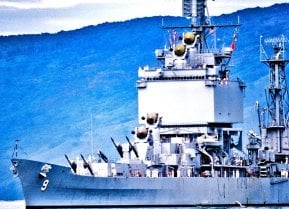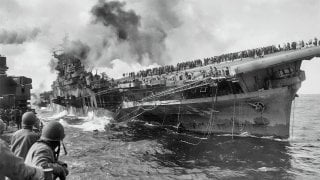Essex-Class Aircraft Carrier USS Franklin Had Just One Mission Only
The USS Franklin (CV-13), part of the prolific Essex-class aircraft carriers, played a pivotal role in World War II's Pacific Theater. Commissioned in 1944, it was named after Benjamin Franklin and the 1775 Revolutionary War schooner.
Summary: The USS Franklin (CV-13), part of the prolific Essex-class aircraft carriers, played a pivotal role in World War II's Pacific Theater with one mission: create havoc for Japan. Commissioned in 1944, it was named after Benjamin Franklin and the 1775 Revolutionary War schooner. The Franklin earned four battle stars but suffered the most sailor casualties of any surviving vessel due to a devastating attack in 1945 near Japan, resulting in over 900 deaths. Despite this, the Franklin was known for significant contributions to the war effort, including key attacks on the Japanese mainland. After the war, it was decommissioned and mothballed, officially stricken in 1964.
USS Franklin: The Heroic WWII Essex-Class Aircraft Carrier with a Tragic Legacy
The Essex-class was the most numerous class of twentieth-century aircraft carriers. One of the most storied vessels among its number was CV-13, known as “Big Ben,” the USS Franklin.
Named for founding father Benjamin Franklin and for the 1775-built schooner that served during the American Revolutionary War, the USS Franklin was commissioned in 1944 and immediately deployed to the Pacific Theater of World War II. She earned four battle stars in that war, as well as one notorious distinction: the most sailors killed in action of any surviving vessel.
USS Franklin Aircraft Carrier: Built for war
The Franklin’s keel was laid down on December 7, 1942, one year after the attack on Pearl Harbor that prompted the commissioning of so many Essex carriers. The Franklin was commissioned on January 31, 1944. The vessel joined Carrier Air Group 13 in the Pacific after a quick shakedown cruise in the Caribbean and further training in San Diego. Finally, in June, the Franklin sailed for Eniwetok Island.
Once installed with the Pacific fleet, the Franklin saw extensive action, beginning with carrier strikes on the Bonin Islands supporting the Mariana Islands assault. Aircraft from the Franklin destroyed Japanese aircraft on the ground and in the air, plus gun installations and enemy ships.
The Franklin then moved on to Guam and Rota Islands, where her aircraft performed similarly, weakening defenses in preparation for the arrival of American invasion forces. In the fall of 1944, the Franklin provided direct air coverage for the Peleliu invasion before returning to the Palau area, where the Franklin’s aircraft made daily patrols.
On September 14, 1944, three Japanese aircraft attacked the Franklin, scoring a bomb hit along the outboard corner of the deck edge elevator. The explosion killed three sailors and wounded another 22. Unfortunately, the three men would be the first of many killed aboard the Franklin.
Sustaining Heavy Damage
Before dawn on March 19, 1945, the Franklin approached the Japanese mainland and launched an attack against Honshu and shipping in Kure Harbor.
A single Yokosuka D4Y “Judy” dive bomber approached the Franklin undetected, dropping two 550-pound bombs. The first bomb struck the flight deck centerline, penetrating the hangar deck. The second bomb hit aft.
The timing was unfortunate: The Franklin had 31 aircraft armed and fueled, waiting to launch another strike against the mainland. The aircraft caught fire almost immediately, and the 15-odd tons of high explosives already loaded onto the plane began to detonate. When the fires were finally extinguished, hundreds had been killed.
More than 900 sailors died aboard the Franklin.
After the war, the Franklin was decommissioned and mothballed. The storied carrier would never sail again and was stricken from the Naval Vessel Registry in 1964.
Harrison Kass is a defense and national security writer with over 1,000 total pieces on issues involving global affairs. An attorney, pilot, guitarist, and minor pro hockey player, Harrison joined the US Air Force as a Pilot Trainee but was medically discharged. Harrison holds a BA from Lake Forest College, a JD from the University of Oregon, and an MA from New York University. Harrison listens to Dokken.
Image: Creative Commons.


